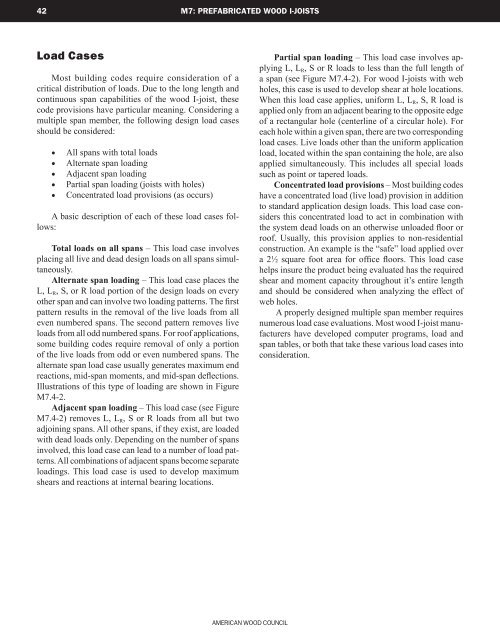ASD/LRFD Manual - American Wood Council
ASD/LRFD Manual - American Wood Council
ASD/LRFD Manual - American Wood Council
You also want an ePaper? Increase the reach of your titles
YUMPU automatically turns print PDFs into web optimized ePapers that Google loves.
42 M7: PREFABRICATED WOOD I-JOISTS<br />
Load Cases<br />
Most building codes require consideration of a<br />
critical distribution of loads. Due to the long length and<br />
continuous span capabilities of the wood I-joist, these<br />
code provisions have particular meaning. Considering a<br />
multiple span member, the following design load cases<br />
should be considered:<br />
• All spans with total loads<br />
• Alternate span loading<br />
• Adjacent span loading<br />
• Partial span loading (joists with holes)<br />
• Concentrated load provisions (as occurs)<br />
A basic description of each of these load cases follows:<br />
Total loads on all spans – This load case involves<br />
placing all live and dead design loads on all spans simultaneously.<br />
Alternate span loading – This load case places the<br />
L, L R , S, or R load portion of the design loads on every<br />
other span and can involve two loading patterns. The first<br />
pattern results in the removal of the live loads from all<br />
even numbered spans. The second pattern removes live<br />
loads from all odd numbered spans. For roof applications,<br />
some building codes require removal of only a portion<br />
of the live loads from odd or even numbered spans. The<br />
alternate span load case usually generates maximum end<br />
reactions, mid-span moments, and mid-span deflections.<br />
Illustrations of this type of loading are shown in Figure<br />
M7.4-2.<br />
Adjacent span loading – This load case (see Figure<br />
M7.4-2) removes L, L R , S or R loads from all but two<br />
adjoining spans. All other spans, if they exist, are loaded<br />
with dead loads only. Depending on the number of spans<br />
involved, this load case can lead to a number of load patterns.<br />
All combinations of adjacent spans become separate<br />
loadings. This load case is used to develop maximum<br />
shears and reactions at internal bearing locations.<br />
Partial span loading – This load case involves applying<br />
L, L R , S or R loads to less than the full length of<br />
a span (see Figure M7.4-2). For wood I-joists with web<br />
holes, this case is used to develop shear at hole locations.<br />
When this load case applies, uniform L, L R , S, R load is<br />
applied only from an adjacent bearing to the opposite edge<br />
of a rectangular hole (centerline of a circular hole). For<br />
each hole within a given span, there are two corresponding<br />
load cases. Live loads other than the uniform application<br />
load, located within the span containing the hole, are also<br />
applied simultaneously. This includes all special loads<br />
such as point or tapered loads.<br />
Concentrated load provisions – Most building codes<br />
have a concentrated load (live load) provision in addition<br />
to standard application design loads. This load case considers<br />
this concentrated load to act in combination with<br />
the system dead loads on an otherwise unloaded floor or<br />
roof. Usually, this provision applies to non-residential<br />
construction. An example is the “safe” load applied over<br />
a 2½ square foot area for office floors. This load case<br />
helps insure the product being evaluated has the required<br />
shear and moment capacity throughout it’s entire length<br />
and should be considered when analyzing the effect of<br />
web holes.<br />
A properly designed multiple span member requires<br />
numerous load case evaluations. Most wood I-joist manufacturers<br />
have developed computer programs, load and<br />
span tables, or both that take these various load cases into<br />
consideration.<br />
<strong>American</strong> <strong>Wood</strong> <strong>Council</strong>

















